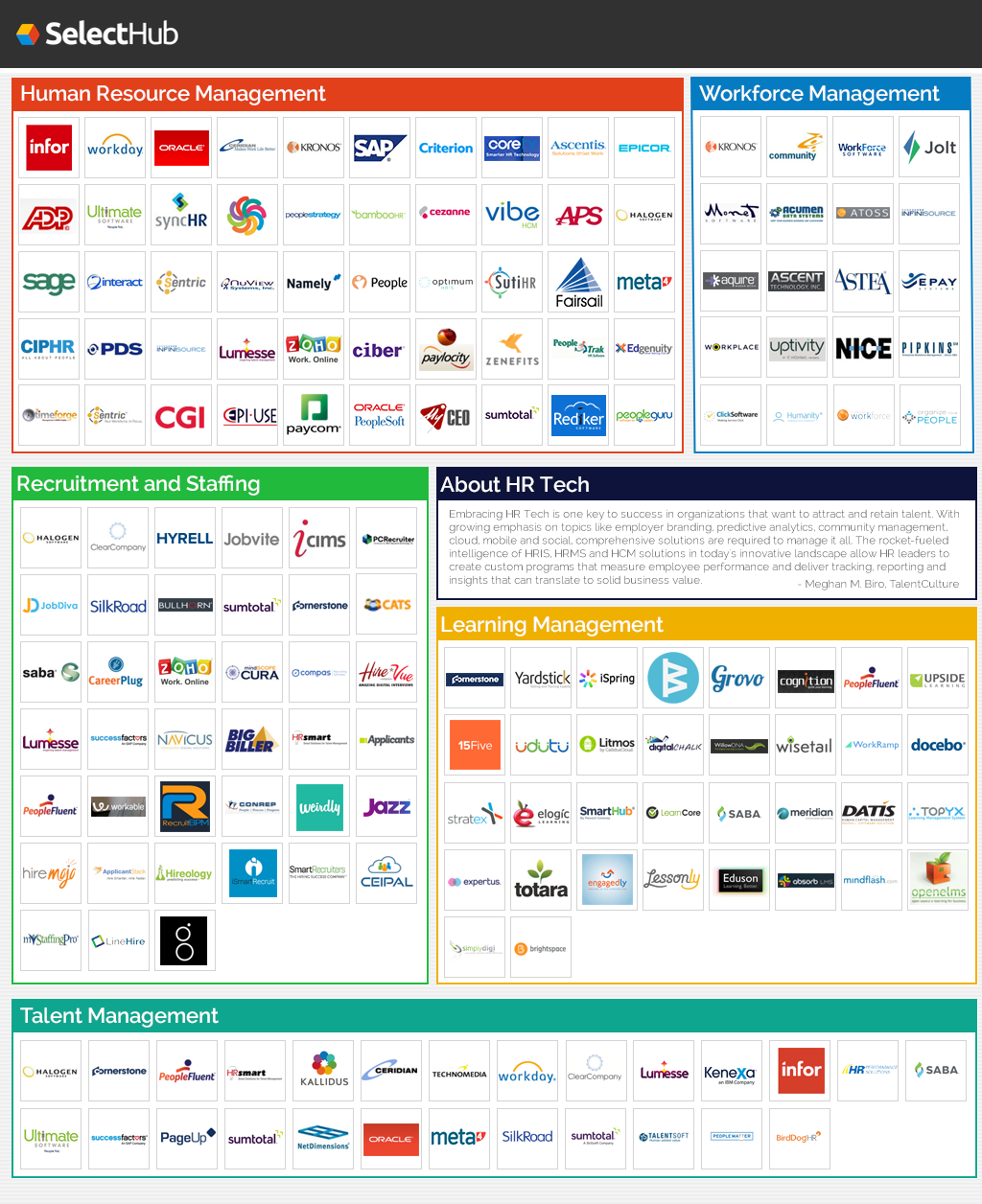The world of human resource management is under siege. Human resources technology has been changing the way HR personnel manage all that they do for years. And there is no sign of slowing. Recruiting, scheduling, employee training and the many other HR functions are being transformed by a sea of innovative software platforms and vendors.
There are dozens of technologies that manage overall human resource management and hundreds more that offer individual functionality in recruiting/staffing, workforce management, talent management and learning management.

Above: VB Profiles HR Technology Landscape. (Disclosure: VB Profiles is a cooperative effort between VentureBeat and Spoke Intelligence.)
This article is part of the HR Technology Landscape. You can download a high-resolution version of it here.
The process of selecting HR tech
As you can see from this sea of HR software, companies have a complicated decision to make. For smaller companies, a streamlined employee scheduling tool may be all that is needed while large organizations may need a full HRM software suite that includes workforce/talent/learning management functionality.
So, how do you know what HR technology your organization needs?
This is where a software requirements gathering exercise is imperative. Software selection requirements gathering is a growing need in companies of all sizes considering how much IT spend is wasted. If HR tech is roughly a $20-40B market (2015) and 70% of IT spend is wasted – billions of dollars are being wasted in poorly selected HR technology.
Using requirements gathering templates and a software selection platform will help you better manage and increase your likelihood of getting the right solution. This is especially important in today’s HR tech cycle considering 40% of companies are planning on a HRMS overhaul.
What’s underneath all of these company logos?
Obviously the accompanying graphic paints a high-level picture of HR technology categories and the bounty of solutions available in each. In reality, these technologies have a deep set of features that can provide real value to any human resource department or recruiting firm.
Wading through all of these possible solutions is a challenging task. Aside from the formal requirements gathering, you have to learn more about the best-fit solutions based on the needs you are after. For example if you’re looking for a Core HR/Human Resource Management solution there are countless product directories that will tell you more about the solution including user ratings and reviews.
Further, you can also delve into all the content each of these HR tech companies provide that will not just educate you on their products but educate you on how to get the most out of HR tech in general.
Understanding the Different Categories of HR Tech
Core human resource management
There are also comprehensive HR software tools that help human resource departments better manage many of their responsibilities. This includes hiring and firing under that general umbrella of HR services, but also includes elements of payroll and other processes that are paperwork-intensive.
The best human resource management platforms have easy and user-friendly modules for payroll, accounting and tax information purposes. They’ll have ways to track the relationships of each individual employee to the business, and they’ll have other functions related to looking at how someone is performing, and tools for discovering any potential problems with their responsibilities in their given job roles.
Recruiting and staffing
Often, the move toward technology starts with bringing people in the door. Companies are moving toward using automated processes for hiring and recruiting – bringing more efficient, digitally supported approaches to finding the best talent in the open market.
Features in these platforms help companies plug in detailed information about each candidate, in much the same way that Customer Relationship Management (CRM) platforms progressively build files on every single prospect and customer.
Talent management
Later in the pipeline, talent management software can support various functions including those of the previous category, recruiting, along with performance management, ongoing learning / employee development programs as well as compensation management.
Workforce management
After people are hired, workforce management tools help companies to approach that big-picture job of managing teams of people and directing them toward results.
Workforce management software has many capabilities from payroll, attendance, forecasting/scheduling, labor budgeting, leave management and more.
Learning management
Learning management software focuses on ongoing employee training, supporting an organization’s ability to retain employees while also helping to improve the quality and productivity of employee’s work. These platforms create the curriculum, deliver online training programs and track employee training progress and results.
Clearly some of these categories have overlapping functionality which is all the more reason to make sure you define your requirements thoroughly.
Wrangling the chaos of human resources
With the development of all of these new products, we can see where HR management is going in the future. Instead of moving forward in a vague environment or in operational chaos, managers will be able to call on particular metrics and analytical platforms to make data-drive decisions.
These software platforms are all part of a newly automated and upgraded digital set of systems that help companies to automate the complicated process of tracking employees, allowing them to focus more keenly on core operations and innovate in their markets. HR technology is fundamentally changing how companies relate to their workers, as we continue into our profoundly data-centric and technical age.
VentureBeat's mission is to be a digital town square for technical decision-makers to gain knowledge about transformative enterprise technology and transact. Learn More

